engine GMC YUKON DENALI 2003 User Guide
[x] Cancel search | Manufacturer: GMC, Model Year: 2003, Model line: YUKON DENALI, Model: GMC YUKON DENALI 2003Pages: 447, PDF Size: 21.97 MB
Page 116 of 447
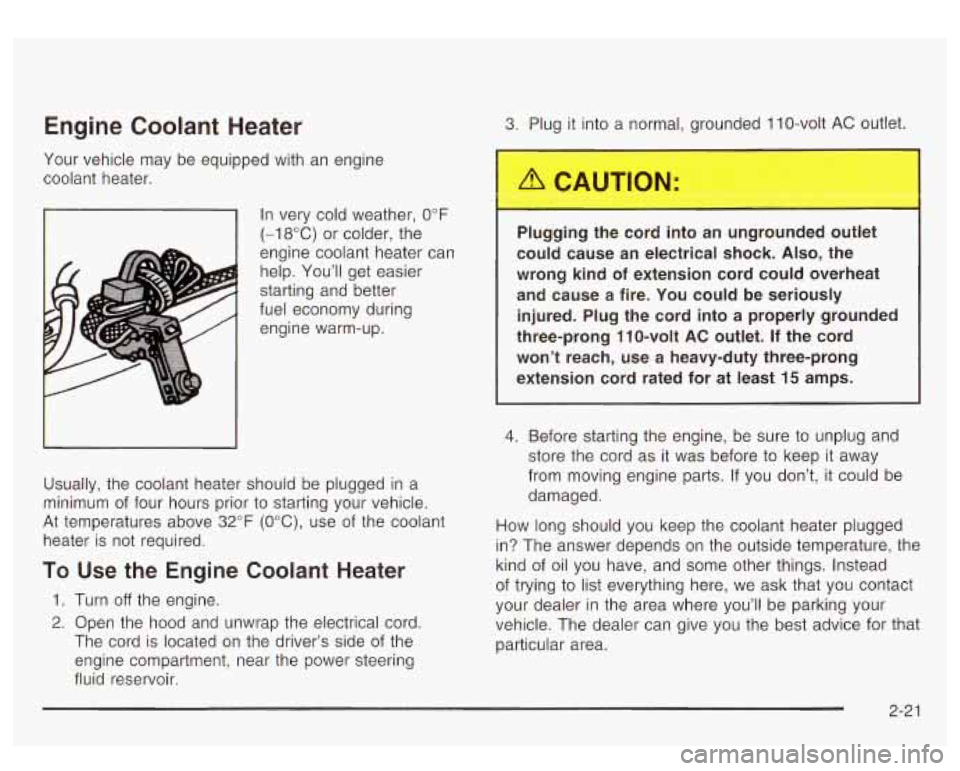
Engine Coolant Heater
Your vehicle may be equipped with an engine
coolant heater.
I
Usually, the coolant heater sho In very cold weather,
0°F
(-18°C) or
colder, the
engine coolant heater can
help. You’ll get easier
starting and better
fuel economy during
engine warm-up.
luld be ph Jgged in a
minimum of four hours prior to starting your vehicle.
At temperatures above 32°F (OOC), use of the coolant
heater is not required.
To Use the Engine Coolant Heater
1. Turn off the engine.
2. Open the hood and unwrap the electrical cord.
The cord is located on the driver’s side of the
engine compartment, near the power steering
fluid reservoir. 3.
Plug it into a normal, grounded 1 IO-volt AC outlet.
PIL,ging the cord inl, an ,..grc,.lded out.,_
could cause an electrical shock. Also, the
wrong kind
of extension cord could overheat
and cause a fire. You could be seriously
injured. Plug the cord into a properly grounded
three-prong
11 0-volt AC outlet. If the cord
won’t reach, use a heavy-duty three-prong
extension cord rated for at least
15 amps.
4. Before starting the engine, be sure to unplug and
store the cord as it was before to keep it away
from moving engine parts.
If you don’t, it could be
damaged.
How long should you keep the coolant heater plugged
in? The answer depends on the outside temperature, the
kind of oil you have, and some other things. Instead
of trying to list everything here, we ask that you contact
your dealer in the area where you’ll be parking your
vehicle. The dealer can give you the best advice for that
particular area.
2-21
Page 117 of 447
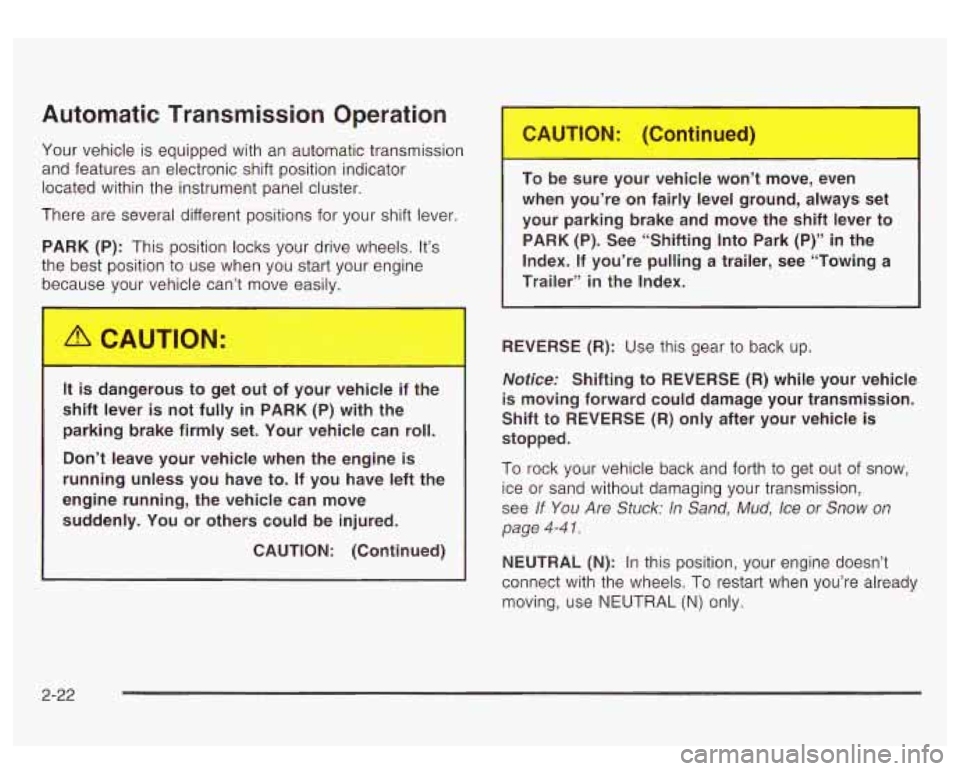
Automatic Transmission Operation
Your vehicle is equipped with an automatic transmission
and features an electronic shift position indicator
located within the instrument panel cluster.
There are several different positions for your shift lever.
PARK
(P): This position locks your drive wheels. It’s
the best position to use when you start your engine
because your -1icle
c ’t move easily.
It is aangerous to get out of your venlcle il
shift lever is not fully in PARK (P) with the
parking brake firmly set. Your vehicle can roll.
Don’t leave your vehicle when the engine is
running unless you have to.
If you have left the
engine running, the vehicle can move
suddenly. You or others could be injured.
CAUTION: (Continued)
o be sure your vehicle won’t move, even
when you’re on fairly level ground, always set
your parking brake and move the shift lever to PARK (P). See “Shifting Into Park (P)” in the
Index.
If you’re pulling a trailer, see “Towing a
Trailer” in the Index.
REVERSE (R): Use this gear to back up.
Notices Shifting to REVERSE (R) while your vehicle
is moving forward could damage your transmission.
Shift to REVERSE
(R) only after your vehicle is
stopped.
To rock your vehicle back and forth to get out of snow,
ice or sand without damaging your transmission,
see If
You Are Stuck: In Sand, Mud, Ice or Snow on
page 4-4 1.
NEUTRAL (N): In this position, your engine doesn’t
connect with the wheels. To restart when you’re already
moving, use NEUTRAL
(N) only.
2-22
Page 118 of 447
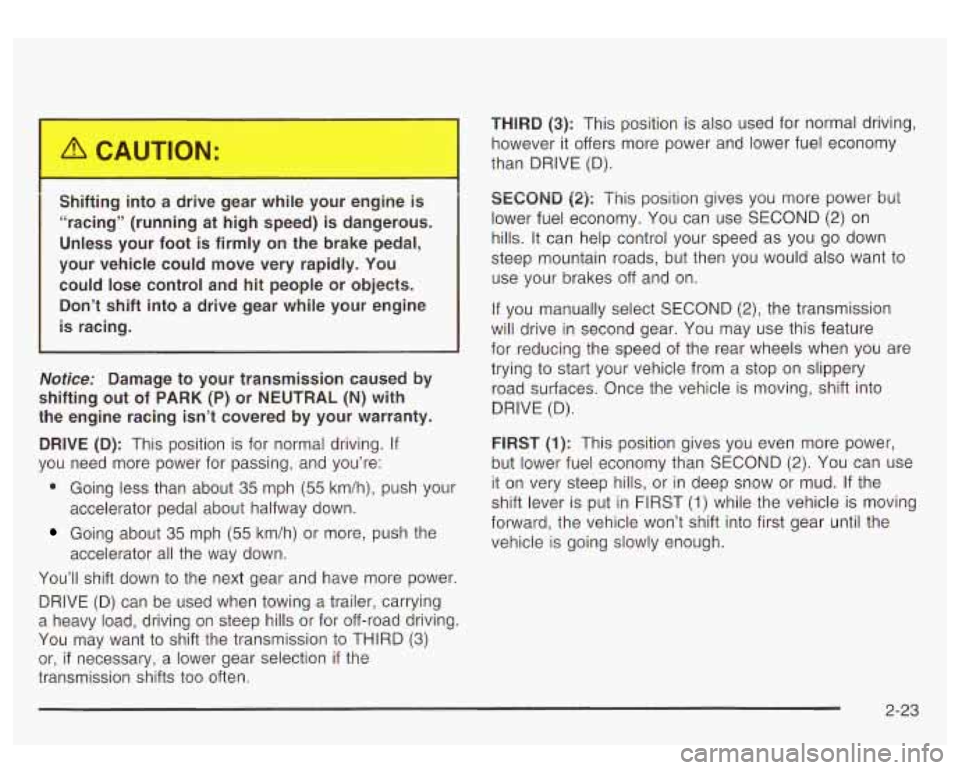
Shifting into a drive gear while your engine is
“racing” (running at high speed) is dangerous.
Unless your foot is firmly on the brake pedal,
your vehicle could move very rapidly. You
could lose control and hit people or objects.
Don’t shift into a drive gear while your engine
is racing.
Notices Damage to your transmission caused by
shifting out of PARK (P) or NEUTRAL (N) with
the engine racing isn’t covered by your warranty.
DRIVE (D):
This position is for normal driving. If
you need more power for passing, and you’re:
accelerator pedal about halfway down.
accelerator all the way down.
0 Going less than about 35 mph (55 km/h), push your
Going about 35 mph (55 km/h) or more, push the
You’ll shift down
to the next gear and have more power.
DRIVE (D) can be used when towing a trailer, carrying
a heavy load, driving on steep hills or for off-road driving.
You may want
to shift the transmission to THIRD (3)
or, if necessary, a lower gear selection if the
transmission shifts
too often.
THIRD (3): This position is also used for normal driving,
however it offers more power and lower fuel economy
than DRIVE (D).
SECOND (2): This position gives you more power but
lower fuel economy. You can use SECOND
(2) on
hills.
It can help control your speed as you go down
steep mountain roads, but then you would also want
to
use your brakes off and on.
If you manually select SECOND
(2), the transmission
will drive in second gear. You may use this feature
for reducing the speed of the rear wheels when you are
trying
to start your vehicle from a stop on slippery
road surfaces. Once the vehicle
is moving, shift into
DRIVE
(D).
FIRST (1): This position gives you even more power,
but lower fuel economy than SECOND
(2). You can use
it on very steep hills, or in deep snow or mud. If the
shift lever is put in FIRST
(1) while the vehicle is moving
forward, the vehicle won’t shift into first gear until the
vehicle is going slowly enough.
2-23
Page 119 of 447
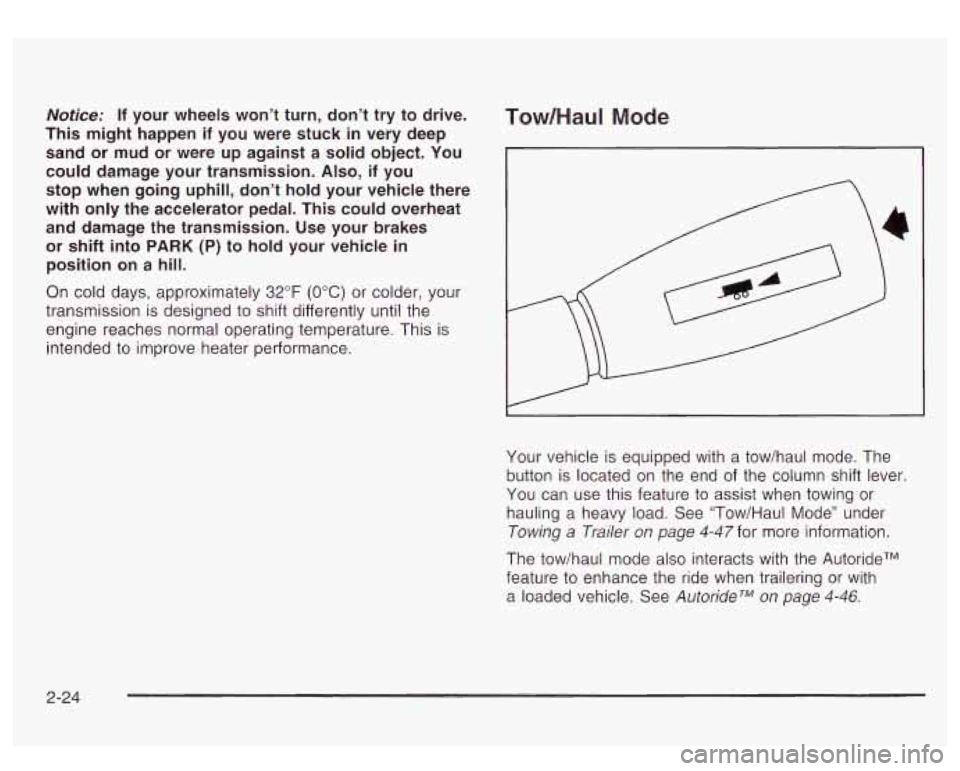
Notice: If your wheels won’t turn, don’t try to drive.
This might happen
if you were stuck in very deep
sand or mud or were up against
a solid object. You
could damage your transmission. Also, if you
stop when going uphill, don’t hold your vehicle there
with only the accelerator pedal. This could overheat
and damage the transmission. Use your brakes
or shift into
PARK (P) to hold your vehicle in
position on
a hill.
On cold days, approximately
32°F (OOC) or colder, your
transmission is designed
to shift differently until the
engine reaches normal operating temperature. This is
intended
to improve heater performance.
Tow/HauI Mode
Your vehicle is equipped with a tow/haul mode. The
button is located on the end
of the column shift lever.
You can use this feature
to assist when towing or
hauling a heavy load. See “Tow/Haul Mode” under
Towing
a Trailer on page 4-47 for more information.
The tow/haul mode also interacts with the AutorideTM
feature
to enhance the ride when trailering or with
a loaded vehicle. See AutorideTM on page
4-46.
2-24
Page 121 of 447
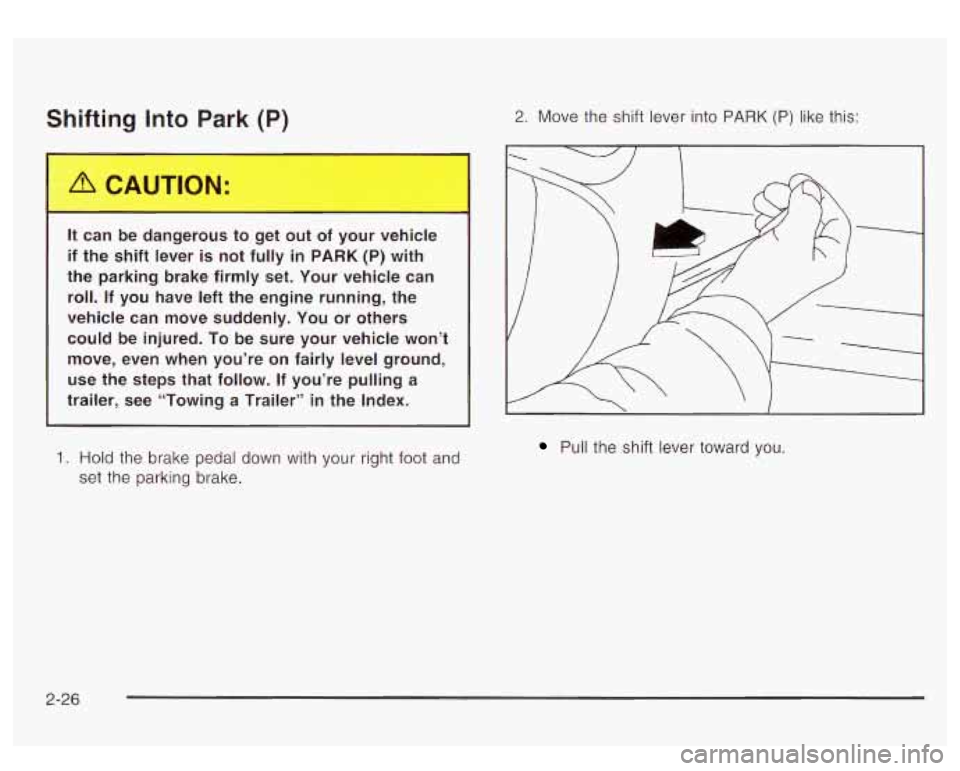
Shifting Into Park (P)
It can be dangerous to get out of your vehicle
if the shift lever is not fully in
PARK (P) with
the parking brake firmly set. Your vehicle can
roll. If you have left the engine running, the
vehicle can move suddenly. You or others
could be injured.
To be sure your vehicle won’t
move, even when you’re on fairly level ground,
use the steps that follow.
If you’re pulling a
trailer, see “Towing a Trailer’’ in the Index.
1. Hold the brake pedal down with your right foot and
set the parking brake.
2. Move the shift lever into PARK (P) like this:
Pull the shift lever toward you.
2-26
Page 122 of 447
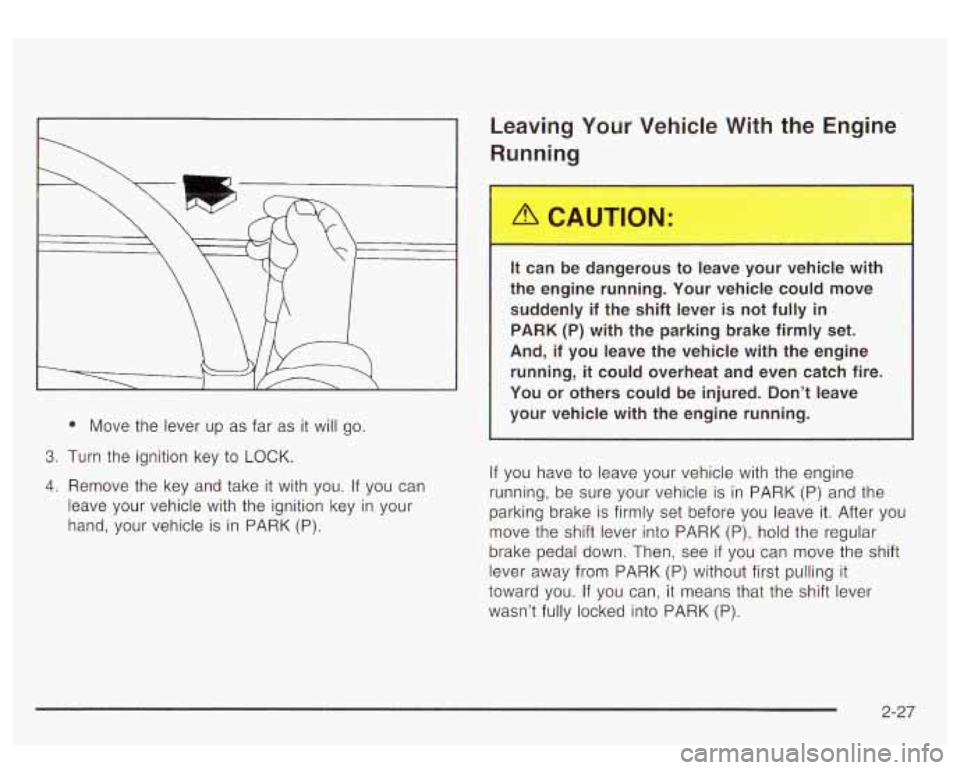
Move the lever up as far as it will go.
3. Turn the ignition key to LOCK.
4. Remove the key and take it with you.
If you can
leave your vehicle with the ignition key in your
hand, your vehicle is in PARK (P).
Leaving Your Vehicle With the Engine
Running
I
It can be dangerous to leave your vehicle with
the engine running. Your vehicle could move suddenly
if the shift lever is not fully in
PARK (P) with the parking brake firmly set.
And,
if you leave the vehicle with the engine
running,
it could overheat and even catch fire.
You or others could be injured. Don’t leave
your vehicle with the engine running.
If you have to leave your vehicle with the engine
running, be sure your vehicle is in PARK (P) and the
parking brake is firmly set before you leave it. After you
move the shift lever into PARK (P): hold the regular
brake pedal down. Then, see
if you can move the shift
lever away from PARK (P) without first pulling it
toward you. If you can, it means that the shift lever
wasn’t fully locked into PARK
(P).
2-27
Page 125 of 447
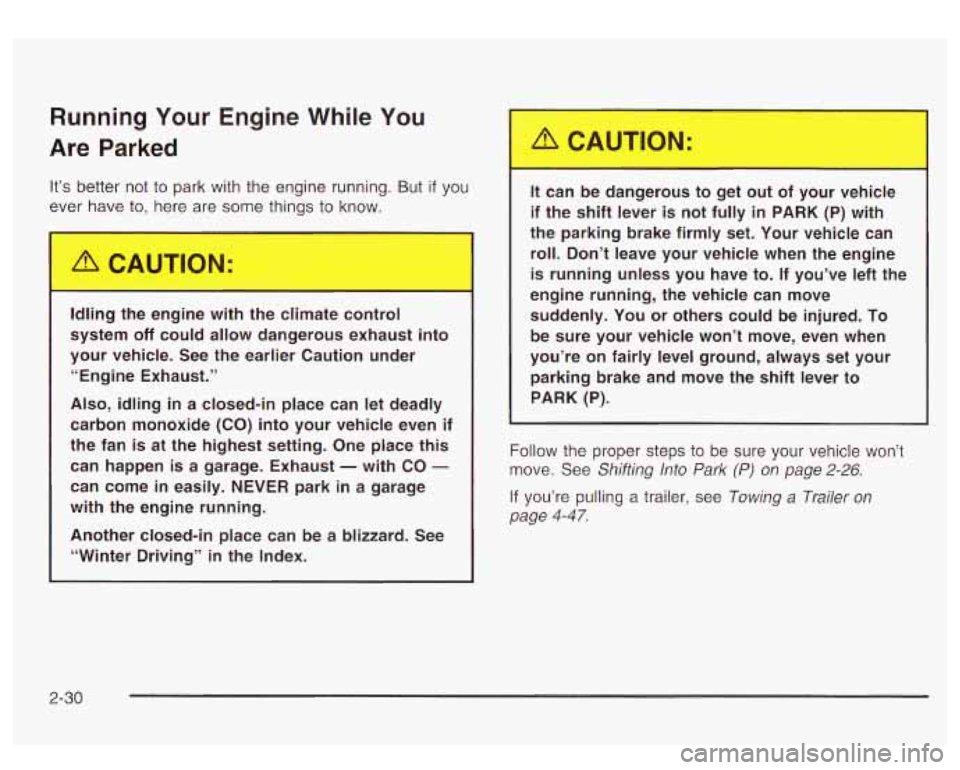
Running Your Engine While You
Are Parked
It’s better not to park with the engine running. But if you
ever have
to, here are some things to know.
Id g the en- le with the climate co ,ol
system off could allow dangerous exhaust into
your vehicle. See the earlier Caution under
“Engine Exhaust.”
Also, idling in a closed-in place can let deadly
carbon monoxide (CO) into your vehicle even
if
the fan is at the highest setting. One place this
can happen is a garage. Exhaust
- with CO -
can come in easily. NEVER park in a garage
with
the engine running.
Another closed-in place can be a blizzard. See
“Winter Driving”
in the Index.
It can be dangerous to get out of your vehicle
if the shift lever is not fully in PARK (P) with
the parking brake firmly set. Your vehicle can
roll. Don’t leave your vehicle when the engine
is running unless you have to.
If you’ve left the
engine running, the vehicle can move
suddenly. You or others could be injured.
To
be sure your vehicle won’t move, even when
you’re on fairly level ground, always set your
parking brake and move
the shift lever to
PARK (P).
Follow the proper steps to be sure your vehicle won’t
move. See Shifting lnto Park
(P) on page 2-26.
If you’re pulling a trailer, see Towing a Trailer on
page
4-47.
2-30
Page 134 of 447
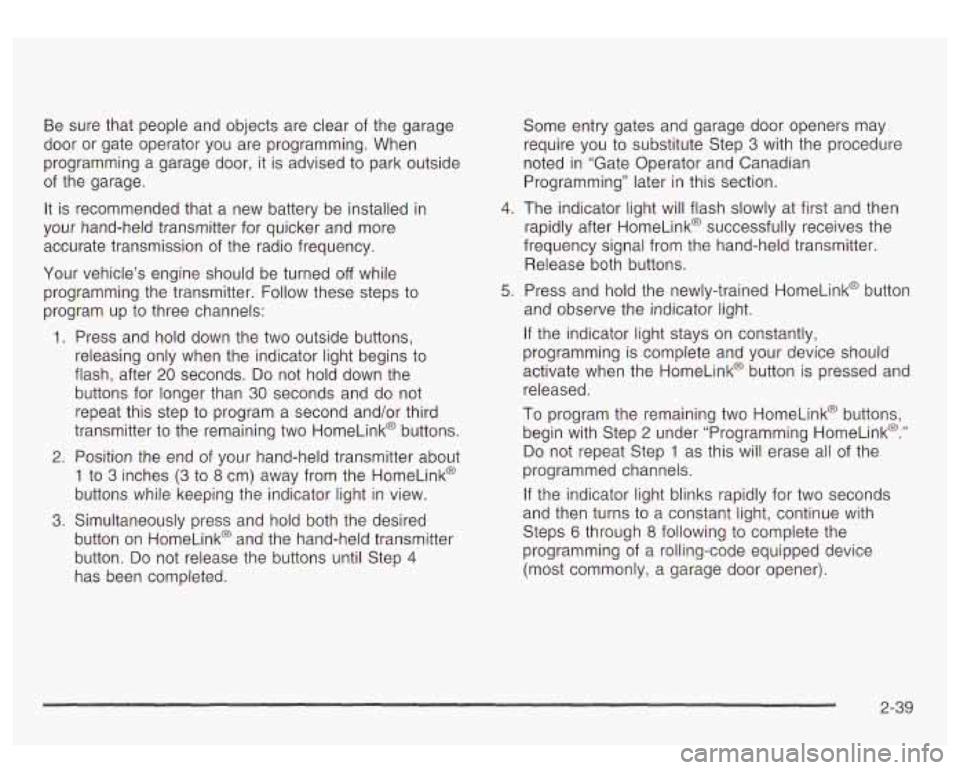
Be sure that people and objects are clear of the garage
door
or gate operator you are programming. When
programming a garage door, it is advised
to park outside
of the garage.
It is recommended that a new battery be installed ip
your hand-held transmitter for quicker and more
accurate transmission of the radio frequency.
Your vehicle’s engine should be turned
off while
programming the transmitter. Follow these steps
to
program up to three channels:
1. Press and hold down the two outside buttons,
releasing only when the indicator light begins
to
flash, after 20 seconds. Do not hold down the
buttons for longer than
30 seconds and do not
repeat this step to program a second and/or third
transmitter
to the remaining two HomeLink@ buttons.
2. Position the end of your hand-held transmitter about
1 to 3 inches (3 to 8 cm) away from the HomeLink@
buttons while keeping the indicator light in view.
3. Simultaneously press and hold both the desired
button on HomeLink@ and the hand-held transmitter
button. Do not release the buttons until Step
4
has been completed. Some entry gates
and garage door openers may
require you
to substitute Step 3 with the procedure
noted
in “Gate Operator and Canadian
Programming” later in this section.
4. The indicator light will flash slowly at first and then
rapidly after HomeLink@ successfully receives the
frequency signal from the hand-held transmitter.
Release both buttons.
5. Press and hold the newly-trained HomeLink@ button
and observe the indicator light.
If the indicator light stays on constantly,
programming
is complete and your device should
activate when the HomeLink@ button is pressed and
released.
To program the remaining two HomeLink@ buttons,
begin with Step
2 under “Programming HomeLink@.”
Do not repeat Step 1 as this will erase all of the
programmed channels.
If the indicator light blinks rapidly for two seconds
and then turns to a constant light, continue with
Steps
6 through 8 following to complete the
programming of a rolling-code equipped device
(most commonly, a garage door opener).
2-39
Page 144 of 447
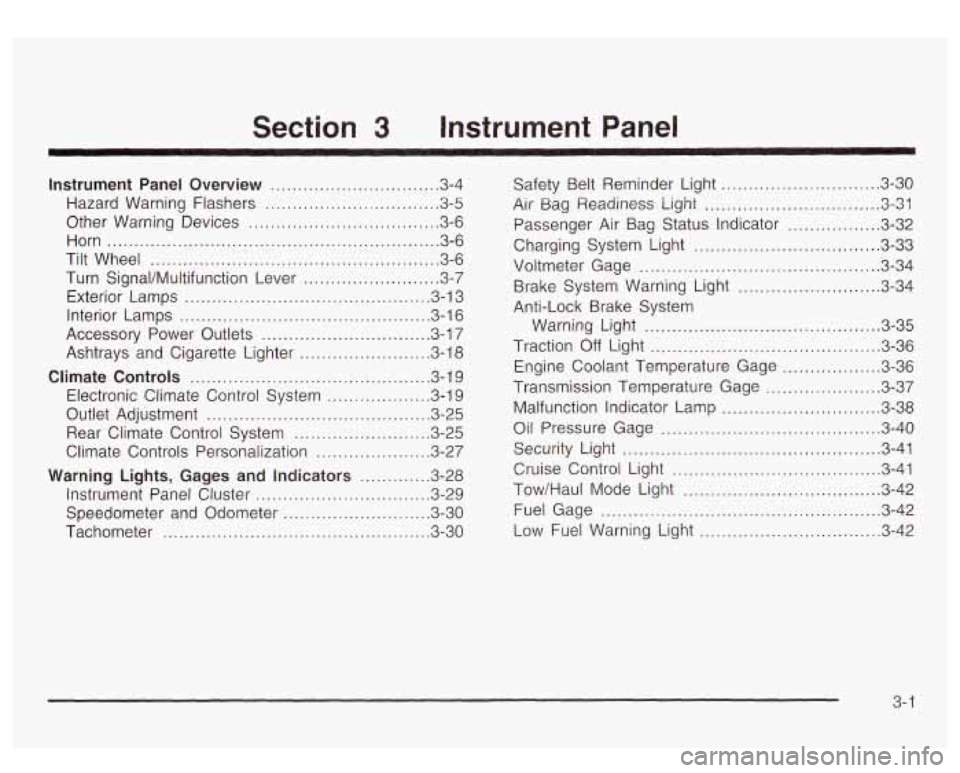
Section 3 Instrument Panel
Instrument Panel Overview ............................... 3.4
Hazard Warning Flashers
................................ 3.5
Other Warning Devices ................................... 3.6
Horn
............................................................. 3.6
Tilt Wheel
..................................................... 3-6
Turn SignaVMultifunction Lever
......................... 3.7
Exterior Lamps
............................................. 3.13
Interior Lamps
.............................................. 3.16
Accessory Power Outlets
............................... 3.17
Ashtrays and Cigarette Lighter
........................ 3.18
Climate Controls ............................................ 3. 1 9
Electronic Climate Control System
................... 3.19
Outlet Adjustment
......................................... 3.25
Rear Climate Control System
......................... 3.25
Climate Controls Personalization
..................... 3.27
Warning Lights, Gages and Indicators ............. 3.28
Instrument Panel Cluster
................................ 3.29
Speedometer and Odometer
........................... 3.30
Tachometer
................................ ......... 3.30
~
Safety Belt Reminder Light ............................. 3.30
Air Bag Readiness Light
................................ 3.31
Passenger Air Bag Status Indicator ................ -3-32
Charging System Light
.................................. 3-33
Voltmeter Gage
............................................ 3-34
Brake System Warning Light
...................... 3-34
Anti-Lock Brake System Warning Light
........................................... 3-35
Traction
Off Light .......................................... 3-36
Transmission Temperature Gage
..................... 3-37
Malfunction Indicator Lamp
............................. 3-38
Oil Pressure Gage ........................................ 3-40
Security Light
............................................... 3-41
Tow/Haul Mode Light .................................... 3-42
Fuel Gage
................................................... 3-42
Low Fuel Warning Light
............................. 3-42
Engine Coolant Temperature Gage
.................. 3-36
Cruise Control
Light ...................................... 3-41
3- 1
Page 158 of 447
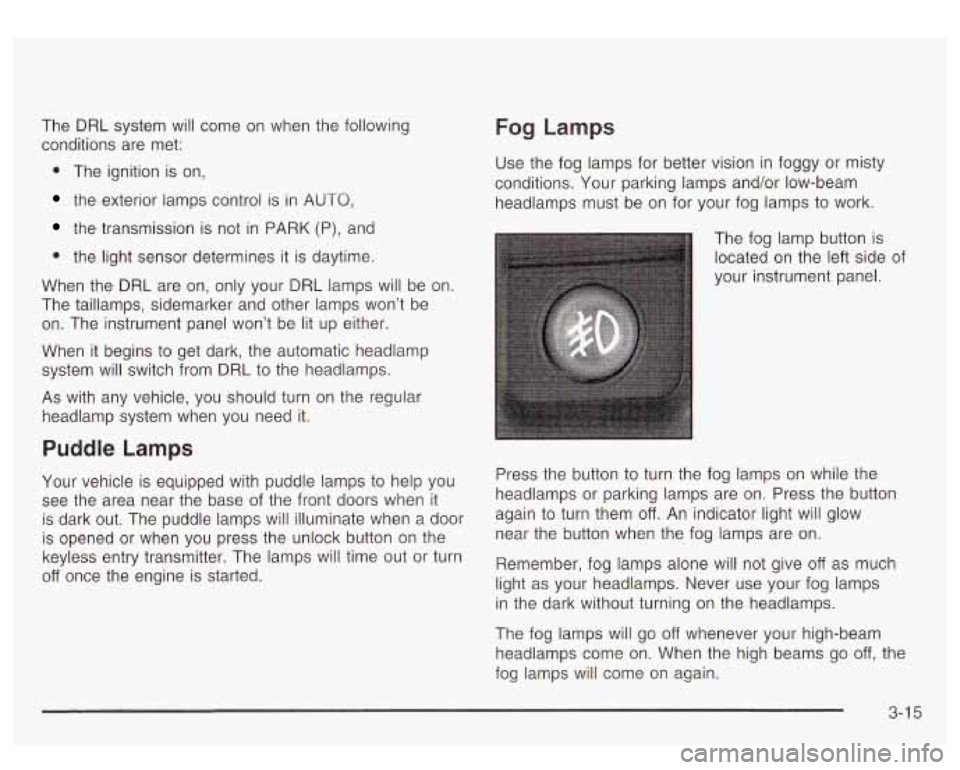
The DRL system will come on when the following
conditions are met:
0 The ignition is on,
the exterior lamps control is in AUTO,
the transmission is not in PARK (P), and
0 the light sensor determines it is daytime.
When the DRL are on, only your DRL lamps will be on
The taillamps, sidemarker and other lamps won’t be
on. The instrument panel won’t be
lit up either.
When it begins
to get dark, the automatic headlamp
system will switch from DRL
to the headlamps.
As with any vehicle, you should turn on the regular
headlamp system when you need it.
Puddle Lamps
Your vehicle is equipped with puddle lamps to help you
see the area near the base of the front doors when
it
is dark out. The puddle lamps will illuminate when a door
is opened or when you press the unlock button on the
keyless entry transmitter. The lamps will time out or turn
off once the engine is started.
Fog Lamps
Use the fog lamps for better vision in foggy or misty
conditions. Your parking lamps and/or low-beam
headlamps must be on for your fog lamps
to work.
The fog lamp button
is
located on the left side of
your instrument panel.
Press the button
to turn the fog lamps on while the
headlamps or parking lamps are on. Press the button
again to turn them
off. An indicator light will glow
near the button when the fog lamps are on.
Remember, fog lamps alone will not give
off as much
light as your headlamps. Never use your fog lamps
in the dark without turning on the headlamps.
The fog lamps will go
off whenever your high-beam
headlamps come on. When the high beams go
off, the
fog lamps will come on again.
3-1 5